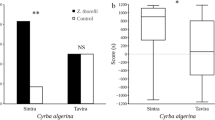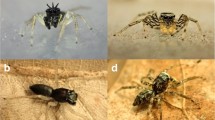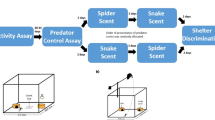Abstract
Geographic variation in a predator’s reliance on kairomones from prey was investigated. The predator studied, Cyrba algerina, is an araneophagic (spider-eating) jumping spider (Salticidae) and the prey were oecobiid spiders (Oecobiidae). There were two study sites (Sintra and Tavira), both in Portugal. Oecobius machadoi was a common oecobiid in Sintra, but no oecobiids were found in Tavira. Staged encounters showed that oecobiid-specific prey-capture behaviour was adopted by the C. algerina in Sintra but not in Tavira. In experiments using a Y-shaped olfactometer, significantly more Sintra C. algerina individuals chose the side with oecobiid odour instead of the blank side when the odour came from females of a sympatric species (O. machadoi), but not when the odour came from O. machadoi males or from females of an allopatric species (O. amboseli). Regardless of whether the odour came from O. machadoi or O. amboseli, the Tavira C. algerina did not choose the odour side significantly more often than the blank side. These findings suggest that, in Sintra, C. algerina is locally adapted to a locally abundant oecobiid species. Whether this example of geographic variation in kairomone use is a behavioural ecotype or instead an instance of phenotypic plasticity is currently unknown.








Similar content being viewed by others
References
Berenbaum MR (1996) Introduction to the symposium: on the evolution of specialization. Am Nat 148(Suppl):S78–S83
Brown WL, Eisner T, Whittaker RH (1970) Allomones and kairomones: transpecific chemical messengers. Bioscience 20:21–22
Carducci JP, Jakob EM (2000) Rearing environment affects behaviour of jumping spiders. Anim Behav 59:39–46
Clark RJ, Harland DP, Jackson RR (2000a) Speculative hunting by an araneophagic salticid spider. Behaviour 137:1601–1612
Clark RJ, Jackson RR, Cutler B (2000b) Chemical cues from ants influence predatory behavior in Habrocestum pulex (Hentz), an ant-eating jumping spider (Araneae, Salticidae). J Arachnol 28:299–341
Curio E (1976) The ethology of predation. Springer, New York
Dawkins R (1980) Good strategy or evolutionary stable strategy? In: Barlow GW, Silverberg J (eds) Sociobiology: beyond nature/nurture? Westview Press, Boulder, pp 331–367
Dicke M, Sabelis MW (1988) Infochemical terminology: based on cost-benefit analysis rather than origin of compounds? Funct Ecol 2:131–139
Foster SA (1999) The geography of behaviour: an evolutionary perspective. Trends Ecol Evol 14:190–195
Guseinov EF, Cerveira AM, Jackson RR (2004) The predatory strategy, natural diet, and life cycle of Cyrba algerina, an araneophagic jumping spider (Salticidae: Spartaeinae) from Azerbaijan. N Z J Zool 31:291–303
Harland DP, Jackson RR (2004) Portia perceptions: The Umwelt of an araneophagic jumping spider. In: Prete FR (ed) Complex worlds from simpler nervous systems. MIT Press, Cambridge, pp 5–40
Huseynov EF, Jackson RR, Cross FR (2008) The meaning of predatory specialization as illustrated by Aelurillus m-nigrum, an ant-eating jumping spider (Araneae: Salticidae) from Azerbaijan. Behav Process 77:389–399
Jackson RR (1988) The biology of Jacksonoides queenlandicus, a jumping spider (Araneae: Salticidae) from Queensland: intraspecific interactions, web-invasion, predators, and prey. N Z J Zool 15:1–37
Jackson RR (1990) Predatory versatility and intraspecific interactions of Cyrba algerina and Cyrba ocellata, web-invading spartaeine jumping spiders (Araneae: Salticidae). N Z J Zool 17:157–168
Jackson RR (1992a) Eight-legged tricksters: spiders that specialize at catching other spiders. Bioscience 42:590–598
Jackson RR (1992b) Conditional strategies and interpopulation variation in the behaviour of jumping spiders. N Z J Zool 19:99–111
Jackson RR, Blest AD (1982) The biology of Portia fimbriata, a web-building jumping spider (Araneae, Salticidae) from Queensland: utilization of webs and predatory versatility. J Zool (Lond) 196:255–293
Jackson RR, Carter CM (2001) Geographic variation in reliance on trial-and-error signal derivation by Portia labiata, an araneophagic jumping spider from the Philippines. J Insect Behav 14:799–827
Jackson RR, Hallas SEA (1986a) Comparative biology of Portia africana, P. albimana, P. fimbriata, P. labiata, and P. schultzi, araneophagic web- building jumping spiders (Araneae: Salticidae): utilisation of silk, predatory versatility, and intraspecific interactions. N Z J Zool 13:423–489
Jackson RR, Hallas SEA (1986b) Predatory versatility and intraspecific interactions of spartaeine jumping spiders (Araneae, Salticidae): Brettus adonis, B. cingulatus, Cyrba algerina and Phaeacius sp. indet. N Z J Zool 13:491–520
Jackson RR, Li D (1998) Prey preferences and visual discrimination ability of Cyrba algerina, an araneophagic jumping spider (Araneae: Salticidae) with primitive retinae. Isr J Zool 44:227–242
Jackson RR, Pollard SD (1996) Predatory behavior of jumping spiders. Annu Rev Entomol 41:287–308
Jackson RR, Wilcox RS (1990) Aggressive mimicry, prey-specific predatory behaviour and predator-recognition in the predator-prey interactions of Portia fimbriata and Euryattus sp., jumping spiders from Queensland. Behav Ecol Sociobiol 26:111–119
Jackson RR, Wilcox RS (1998) Spider-eating spiders. Am Sci 86:350–357
Jackson RR, Li DQ, Fijn N, Barrion A (1998) Predator-prey interactions between aggressive-mimic jumping spiders (Salticidae) and araneophagic spitting spiders (Scytodidae) from the Philippines. J Insect Behav 11:319–342
Jackson RR, Clark RJ, Harland DP (2002a) Behavioural and cognitive influences of kairomones on an araneophagic spider. Behaviour 139:749–775
Jackson RR, Pollard SD, Li DQ, Fijn N (2002b) Interpopulation variation in the risk-related decisions of Portia labiata, an araneophagic jumping spider (Araneae, Salticidae), during predatory sequences with spitting spiders. Anim Cogn 5:215–223
Jackson RR, Nelson XJ, Sune GO (2005) A spider that feeds indirectly on vertebrate blood by choosing female mosquitoes as prey. Proc Natl Acad Sci USA 102:15155–15160
Land MF (1969) Structure of the retinae of the principal eyes of jumping spiders (Salticidae: Dendryphantinae) in relation to visual optics. J Exp Biol 51:443–470
Land MF, Nilsson DE (2002) Animal eyes. Oxford University Press, Oxford
Li D, Jackson RR (2003) A predator’s preference for egg-carrying prey: a novel cost of parental care. Behav Ecol Sociobiol 55:129–136
Persons MH, Uetz GW (1996) Wolf spiders vary patch residence time in the presence of chemical cues from prey (Araneae, Lycosidae). J Arachnol 24:76–79
Richman DB, Jackson RR (1992) A review of the ethology of jumping spiders (Araneae, Salticidae). Bull Br Arachnol Soc 9:33–37
Ruther J, Meiners T, Steidle JLM (2002) Rich in phenomena-lacking in terms. A classification of kairomones. Chemoecology 12:161–167
Sokal RR, Rohlf FJ (1995) Biometry: the principles of statistics in biological research. Freeman, New York
Su KFY, Meier R, Jackson RR, Harland DP, Li D (2007) Convergent evolution of eye ultrastructure and divergent evolution of vision-mediated predatory behaviour in jumping spiders. J Evol Biol 20:1478–1489
Turesson G (1922) The species and the variety as ecological units. Hereditas 3:100–113
Wanless FR (1984a) A review of the spider subfamily Spartaeinae nom n. (Araneae: Salticidae) with descriptions of six new genera. J Zool (Lond) 46:135–205
Wanless FR (1984b) A revision of the spider genus Cyrba (Araneae, Salticidae) with the description of a new presumptive pheromone dispersing organ. Bull Br Mus Nat Hist (Zool) 47:445–481
West-Eberhard MJ (2003) Developmental plasticity and evolution. Oxford University Press, New York
Williams DS, McIntyre P (1980) The principal eyes of a jumping spider have a telephoto component. Nature 228:578–580
Acknowledgments
For a Doctoral Scholarship (SFRH/BD/8311/2002) to A.M.C. through the European Regional Development Fund, we thank the Fundação para a Ciência e a Tecnologia. We also thank the Royal Society of New Zealand for funding to R.R.J. (a grant from the Marsden Fund and a James Cook Fellowship) and three anonymous reviewers for comments on the manuscript.
Author information
Authors and Affiliations
Corresponding author
About this article
Cite this article
Cerveira, A.M., Jackson, R.R. Interpopulation variation in kairomone use by Cyrba algerina, an araneophagic jumping spider from Portugal. J Ethol 29, 121–129 (2011). https://doi.org/10.1007/s10164-010-0233-1
Received:
Accepted:
Published:
Issue Date:
DOI: https://doi.org/10.1007/s10164-010-0233-1




